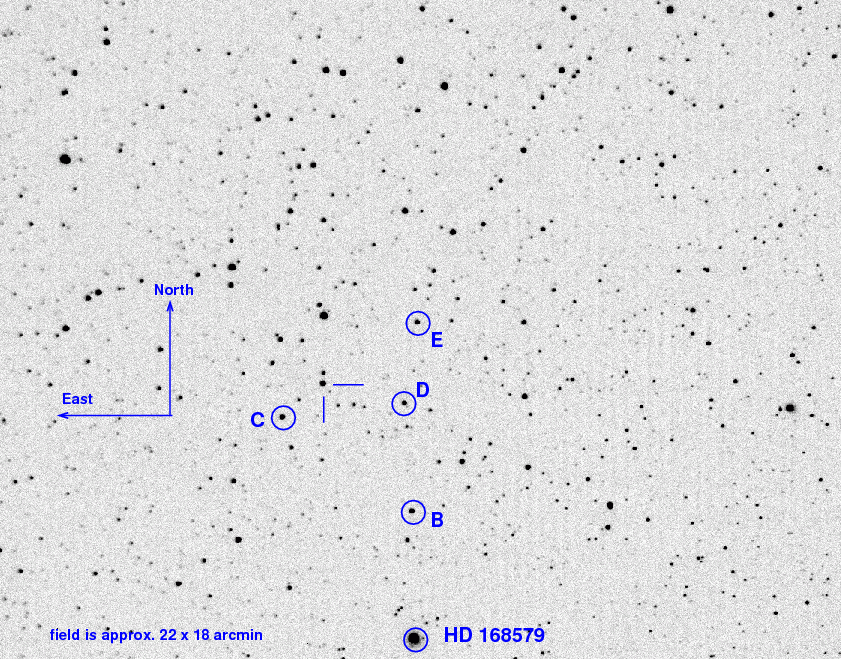
On the night of Jul 08/09 2018, from about 10:30 PM until dawn, through mostly clear, dark skies, I acquired a set of observations of the likely black-hole system MAXIJ1820+070, (also known as ASASSN-18ey ).
I used the guider again, and plan to do so in the future. The altitude axis of the mount needs a small adjustment.
The main setup was:
Notes from the night:
This optical and X-ray and radio transient is likely a black hole accreting material at a higher-than-usual rate. It has been the subject of many observers over the past few months -- see the trail of telegrams that include
The object is located at
RA = 18:20:21.9 Dec = +07:11:07.3
A chart of the field is shown below. The size of the chart is about 22 by 18 arcminutes.
I've marked the location of several comparison stars, which also appear in light curves below. Stars C, D, and E are mentioned by the Tomoe Gozen team in ATel 11426, but all three are rather red, with (B-V) ranging from 1.14 to 1.37. Star B is one of the bluest nearby bright stars, with (B-V) = 0.52.
star UCAC4 B V ---------------------------------------------------- B 486-079513 12.975 12.454 C 486-079608 13.968 12.830 D 486-079523 14.637 13.272 E 487-077858 14.637 13.272 ----------------------------------------------------
I ran the camera at -17 C. Nothing out of the ordinary.

The sky value shows no clouds!

Here's a record of the telescope's drift. With the guider, there's no long-term drift in RA, but a slow drift in Dec remains.
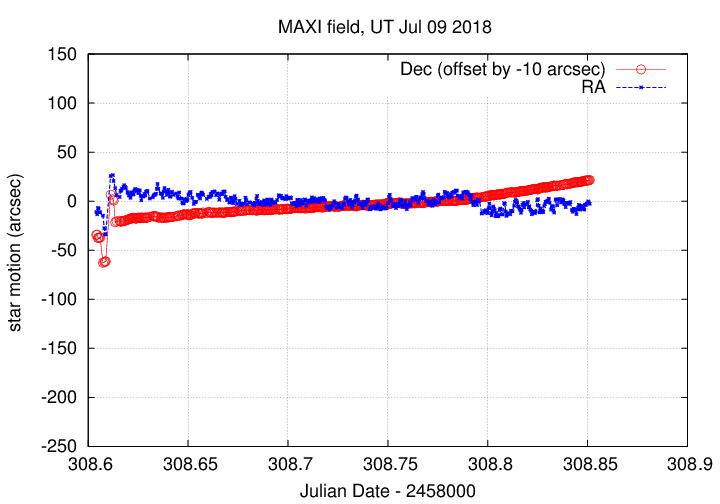
The number of objects detected -- I required 50 objects for an image to be included in the ensemble.
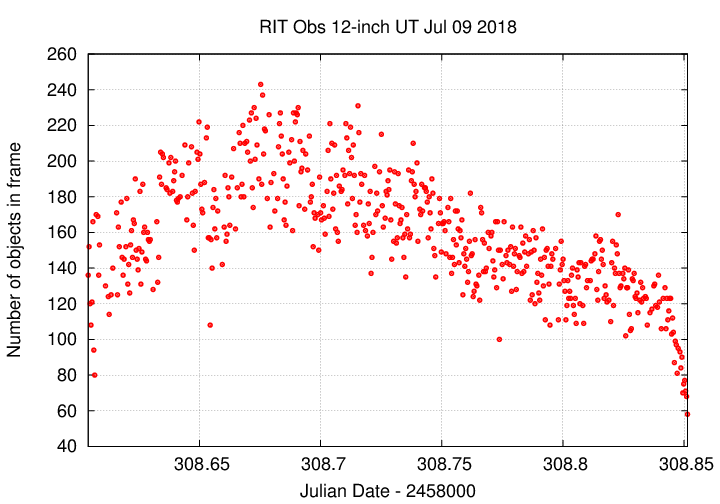
I used an aperture with radius 5.0 pixels. I adjusted the focus position from 0.927 -> 0.947 at 11:11 PM = JD 308.633. I made further adjustments later, but I think I tried to make too many. I should let the focus drift quite a way before changing things a bit at a time.

I discarded images which had obvious trailed stellar images, using a threshold of "round > -0.40". (104 of the 638 raw images). I also removed all images with an image adjustment (zero-point) value more than 0.3 mag above the baseline, removing another 4 images.
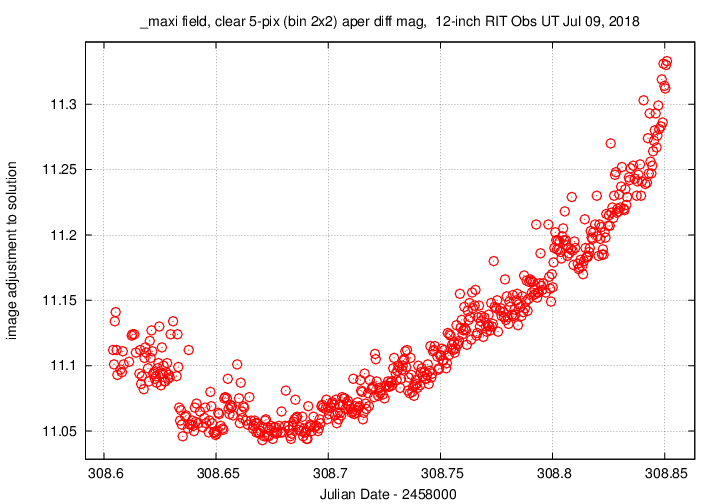
Using aperture photometry with a radius of 5 pixels (binned 2x2, each pixel is 1.34 arcsec, so a radius of 6.7 arcsec), I measured the instrumental magnitudes of a number of reference stars and the target. Following the procedures outlined by Kent Honeycutt's article on inhomogeneous ensemble photometry, I used all stars available in each image to define a reference frame, and measured each star against this frame.
Sigma-vs-mag plots show that the floor was about 0.008 mag overall, which is good. I marked star "A" as variable in the ensemble, as it was slightly saturated. The small outlier around instrumental magnitude 2.5 is MAXI J1820+070.
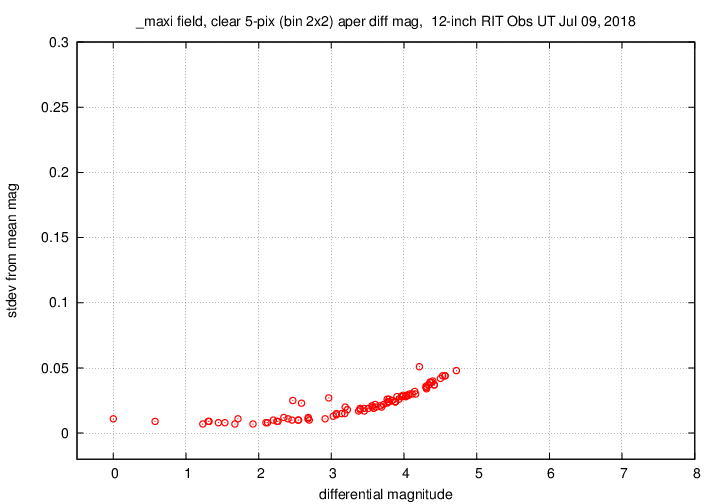
Here are light curves of the variable and the field stars.
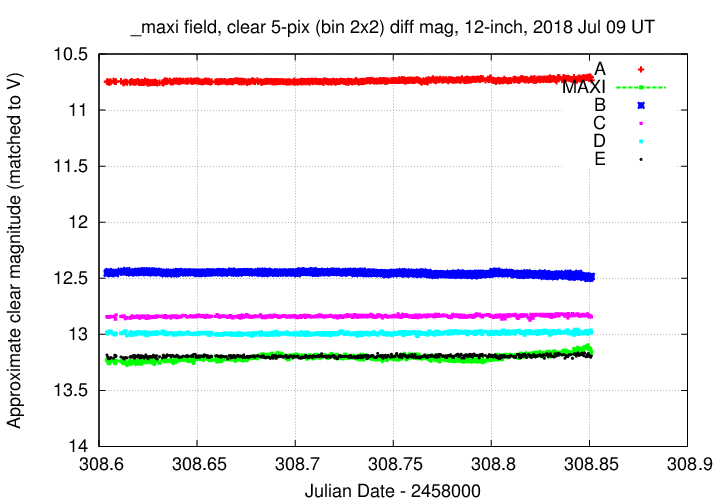
I used the UCAC value for the V-band magnitude of star "B" = UCAC4 486-079513 to shift the ensemble magnitudes to the standard V-band scale -- but remember that these are UNFILTERED measurements.
Here's a closeup on the variable. I'll connect the dots to make its behavior a bit easier to see.
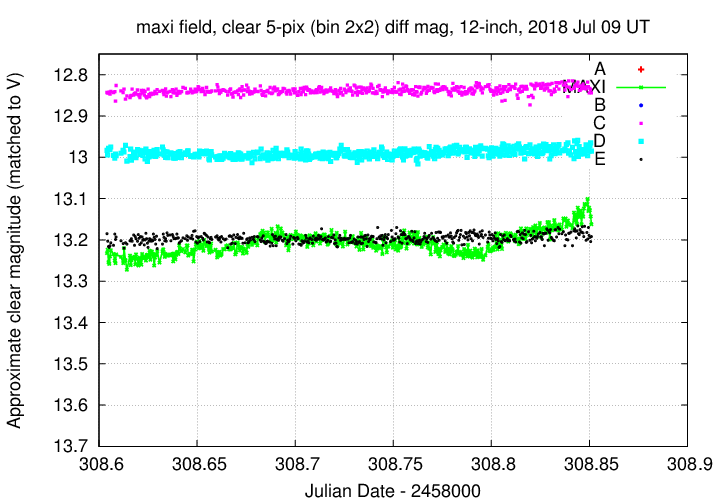
You can download my measurements below. A copy of the header of the file is shown to explain the format.
# Measurements of MAXIJ1820+070 made at RIT Obs, UT 2018 Jul 9, # in very good conditions, # by Michael Richmond, # using Meade 12-inch LX200 and ATIK 11000. # Exposures 25 seconds long, no filter. # Tabulated times are midexposure (FITS header time - half exposure length) # and accurate only to +/- 1 second (??). # 'mag' is a differential magnitude based on ensemble photometry # using a circular aperture of radius 5 pix = 6.6 arcseconds. # which has been shifted so UCAC4 486-079513 has mag=12.454 # which is its V-band magnitude according to UCAC4. # # UT_day JD HJD mag uncert Jul09.10407 2458308.60407 2458308.60904 13.232 0.012 Jul09.10446 2458308.60446 2458308.60943 13.224 0.011 Jul09.10485 2458308.60485 2458308.60982 13.254 0.012
Last modified 7/09/2018 by MWR.